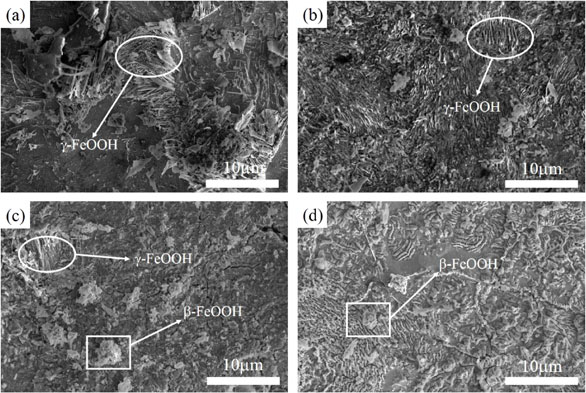Volume 61, Issue 12
Displaying 1-27 of 27 articles from this issue
- |<
- <
- 1
- >
- >|
Regular Article
Microstructure of Materials
-
Article type: Regular Article
2020Volume 61Issue 12 Pages 2253-2262
Published: December 01, 2020
Released on J-STAGE: November 25, 2020
Advance online publication: November 06, 2020Download PDF (8393K) Full view HTML -
Article type: Regular Article
2020Volume 61Issue 12 Pages 2263-2269
Published: December 01, 2020
Released on J-STAGE: November 25, 2020
Advance online publication: October 16, 2020Download PDF (6861K) Full view HTML -
Article type: Regular Article
2020Volume 61Issue 12 Pages 2270-2275
Published: December 01, 2020
Released on J-STAGE: November 25, 2020
Advance online publication: October 30, 2020Download PDF (3946K) Full view HTML
Mechanics of Materials
-
Article type: Regular Article
2020Volume 61Issue 12 Pages 2276-2283
Published: December 01, 2020
Released on J-STAGE: November 25, 2020
Advance online publication: November 06, 2020Download PDF (2965K) Full view HTML -
Article type: Regular Article
2020Volume 61Issue 12 Pages 2284-2291
Published: December 01, 2020
Released on J-STAGE: November 25, 2020
Advance online publication: November 06, 2020Download PDF (5153K) Full view HTML -
Article type: Regular Article
2020Volume 61Issue 12 Pages 2292-2301
Published: December 01, 2020
Released on J-STAGE: November 25, 2020
Advance online publication: October 23, 2020Download PDF (6459K) Full view HTML -
Article type: Regular Article
2020Volume 61Issue 12 Pages 2302-2306
Published: December 01, 2020
Released on J-STAGE: November 25, 2020
Advance online publication: October 09, 2020Download PDF (2130K) Full view HTML -
Article type: Regular Article
2020Volume 61Issue 12 Pages 2307-2311
Published: December 01, 2020
Released on J-STAGE: November 25, 2020
Advance online publication: October 23, 2020Download PDF (2768K) Full view HTML -
Article type: Regular Article
2020Volume 61Issue 12 Pages 2312-2319
Published: December 01, 2020
Released on J-STAGE: November 25, 2020
Download PDF (5895K) Full view HTML -
Article type: Regular Article
2020Volume 61Issue 12 Pages 2320-2328
Published: December 01, 2020
Released on J-STAGE: November 25, 2020
Advance online publication: October 30, 2020Download PDF (4775K) Full view HTML
Materials Chemistry
-
Article type: Regular Article
2020Volume 61Issue 12 Pages 2329-2335
Published: December 01, 2020
Released on J-STAGE: November 25, 2020
Advance online publication: October 23, 2020Download PDF (6145K) Full view HTML -
Article type: Regular Article
2020Volume 61Issue 12 Pages 2336-2341
Published: December 01, 2020
Released on J-STAGE: November 25, 2020
Advance online publication: October 23, 2020Download PDF (1222K) Full view HTML -
Article type: Regular Article
2020Volume 61Issue 12 Pages 2342-2347
Published: December 01, 2020
Released on J-STAGE: November 25, 2020
Advance online publication: October 30, 2020Download PDF (5913K) Full view HTML -
Article type: Regular Article
2020Volume 61Issue 12 Pages 2348-2356
Published: December 01, 2020
Released on J-STAGE: November 25, 2020
Advance online publication: October 23, 2020Download PDF (3372K) Full view HTML -
Article type: Regular Article
2020Volume 61Issue 12 Pages 2357-2362
Published: December 01, 2020
Released on J-STAGE: November 25, 2020
Advance online publication: October 30, 2020Download PDF (732K) Full view HTML
Materials Processing
-
Article type: Regular Article
2020Volume 61Issue 12 Pages 2363-2370
Published: December 01, 2020
Released on J-STAGE: November 25, 2020
Download PDF (7064K) Full view HTML -
Article type: Regular Article
2020Volume 61Issue 12 Pages 2371-2377
Published: December 01, 2020
Released on J-STAGE: November 25, 2020
Download PDF (5587K) Full view HTML -
Article type: Regular Article
2020Volume 61Issue 12 Pages 2378-2385
Published: December 01, 2020
Released on J-STAGE: November 25, 2020
Download PDF (4780K) Full view HTML -
Article type: Regular Article
2020Volume 61Issue 12 Pages 2386-2392
Published: December 01, 2020
Released on J-STAGE: November 25, 2020
Advance online publication: November 06, 2020Download PDF (6434K) Full view HTML -
Article type: Regular Article
2020Volume 61Issue 12 Pages 2393-2401
Published: December 01, 2020
Released on J-STAGE: November 25, 2020
Download PDF (5403K) Full view HTML
Engineering Materials and Their Applications
-
Article type: Regular Article
2020Volume 61Issue 12 Pages 2402-2406
Published: December 01, 2020
Released on J-STAGE: November 25, 2020
Download PDF (1186K) Full view HTML -
Article type: Regular Article
2020Volume 61Issue 12 Pages 2407-2411
Published: December 01, 2020
Released on J-STAGE: November 25, 2020
Advance online publication: October 30, 2020Download PDF (1739K) Full view HTML -
Article type: Regular Article
2020Volume 61Issue 12 Pages 2412-2418
Published: December 01, 2020
Released on J-STAGE: November 25, 2020
Advance online publication: October 23, 2020Download PDF (3663K) Full view HTML -
Article type: Regular Article
2020Volume 61Issue 12 Pages 2419-2427
Published: December 01, 2020
Released on J-STAGE: November 25, 2020
Download PDF (5072K) Full view HTML
Environment
-
Article type: Regular Article
2020Volume 61Issue 12 Pages 2428-2434
Published: December 01, 2020
Released on J-STAGE: November 25, 2020
Download PDF (3730K) Full view HTML
Current Trends in Research
-
Article type: Current Trends in Research
2020Volume 61Issue 12 Pages 2435-2441
Published: December 01, 2020
Released on J-STAGE: November 25, 2020
Download PDF (2573K) Full view HTML
Express Rapid Publication
-
Article type: Express Rapid Publication
2020Volume 61Issue 12 Pages 2442-2445
Published: December 01, 2020
Released on J-STAGE: November 25, 2020
Advance online publication: October 30, 2020Download PDF (1940K) Full view HTML
- |<
- <
- 1
- >
- >|






















